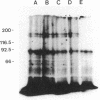Abstract
Since radioiodination of human granulocyte colony-stimulating factor (G-CSF) is difficult, we synthesized a mutein of human G-CSF that retains full biological activity and receptor-binding capacity for at least 2 weeks after radioiodination. Receptors for human G-CSF were characterized in the plasma membrane fraction from the human term placenta (human placental membranes) and trophoblastic cells by using the 125I-labeled mutein of human G-CSF (KW-2228). The specific binding of 125I-labeled KW-2228 to placental membranes was pH-dependent, with maximal specific binding at pH 7.8; it increased linearly with protein to 3.7 mg of protein per ml and was both time- and temperature-dependent, with maximal binding at 4 degrees C after a 24-hr incubation. When we examined the ability of hematopoietic growth factors to inhibit 125I-labeled KW-2228 binding, we found that KW-2228 and intact human G-CSF inhibited 125I-labeled KW-2228 binding, whereas erythropoietin or granulocyte-macrophage colony-stimulating factor did not. Scatchard analysis revealed a single receptor type with a Bmax of 210 fmol/mg of protein and a Kd of 480 pM. The human G-CSF receptors on human placental membranes were shown to consist of two molecular species of 150 kDa and 120 kDa that could be specifically cross-linked to 125I-labeled KW-2228. Human trophoblastic cells, T3M-3, also possessed a single receptor for G-CSF with a Bmax of 533 receptors per cell and a Kd of 390 pM. Thus we have identified the receptor for human G-CSF on human placental membranes and trophoblastic cells, and the presence of this receptor in these membranes suggests that human G-CSF plays some role in the feto-placental unit during human development.
Full text
PDF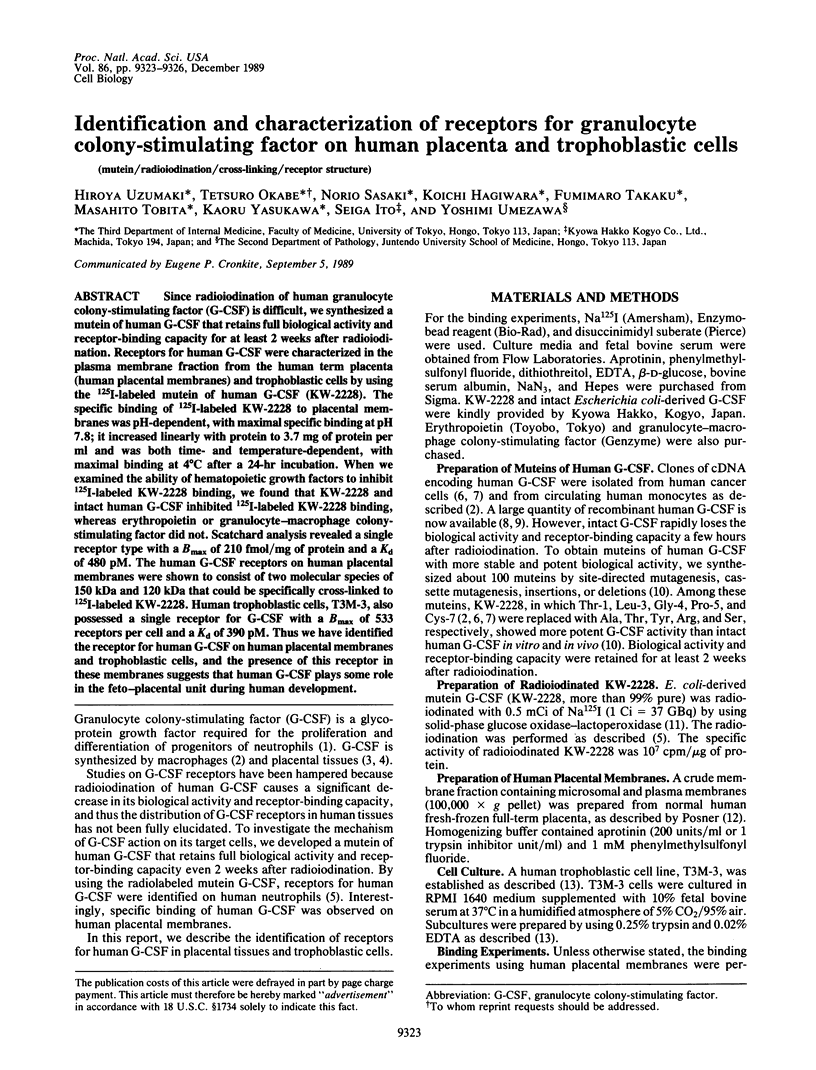
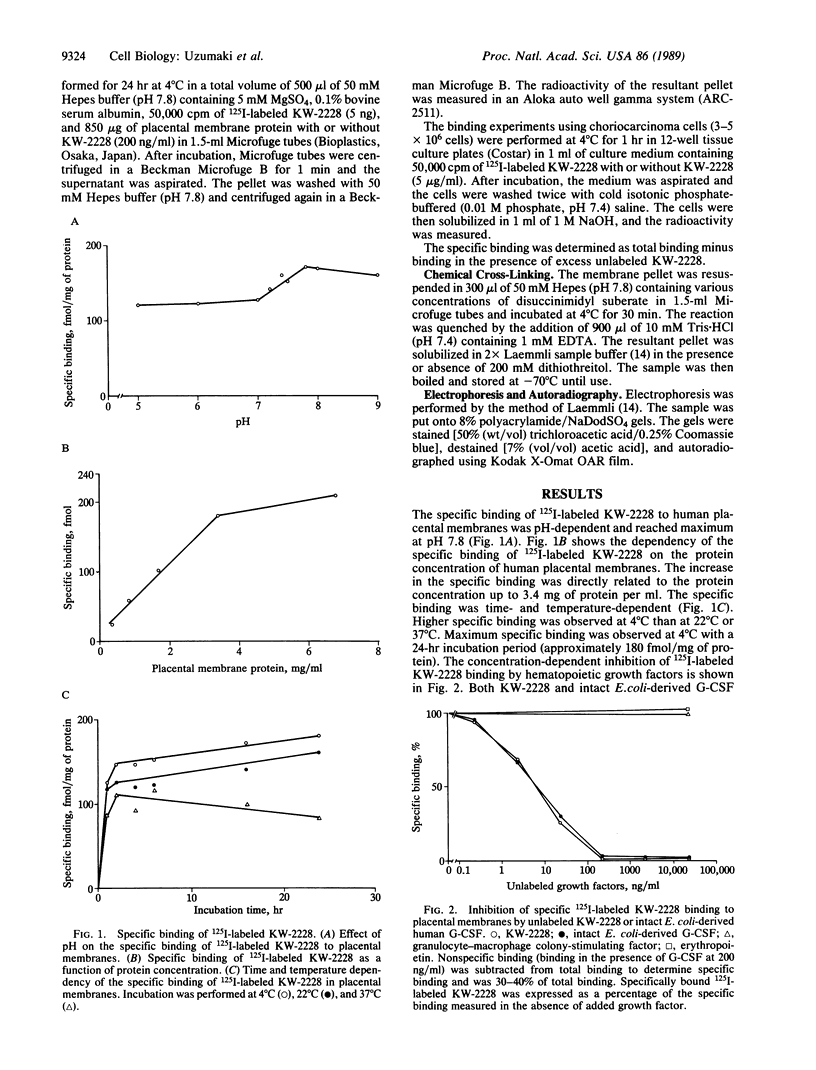
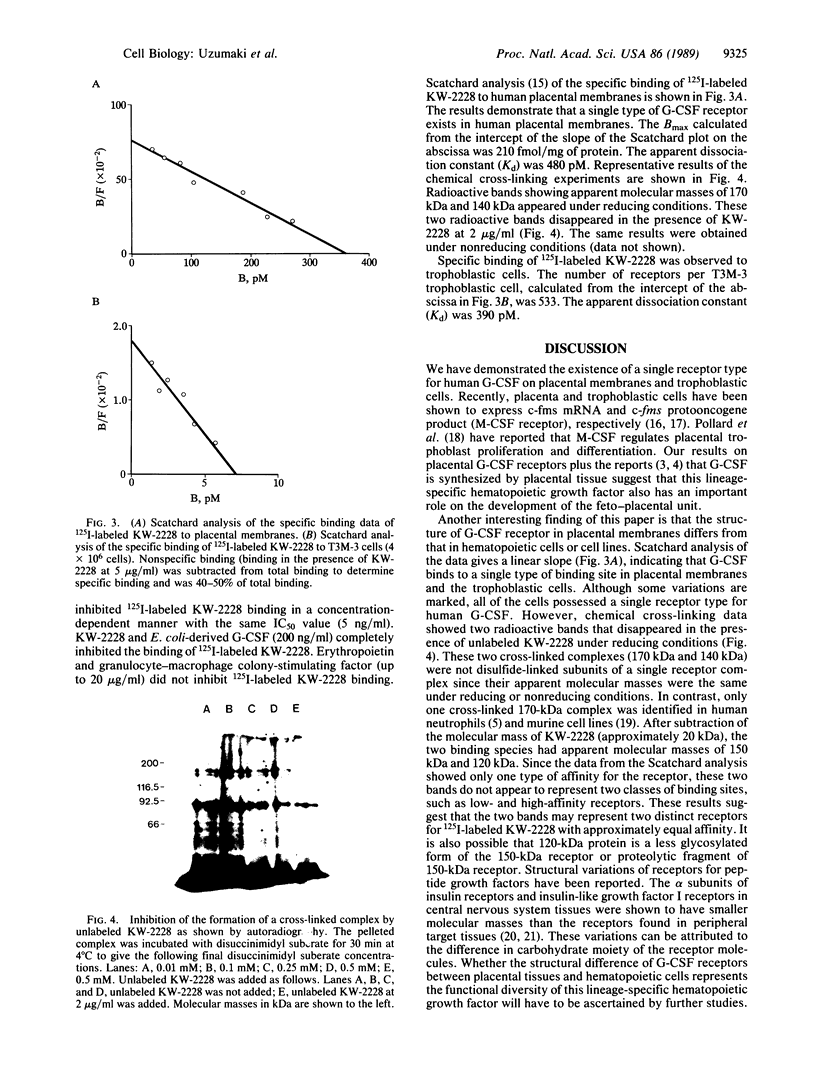
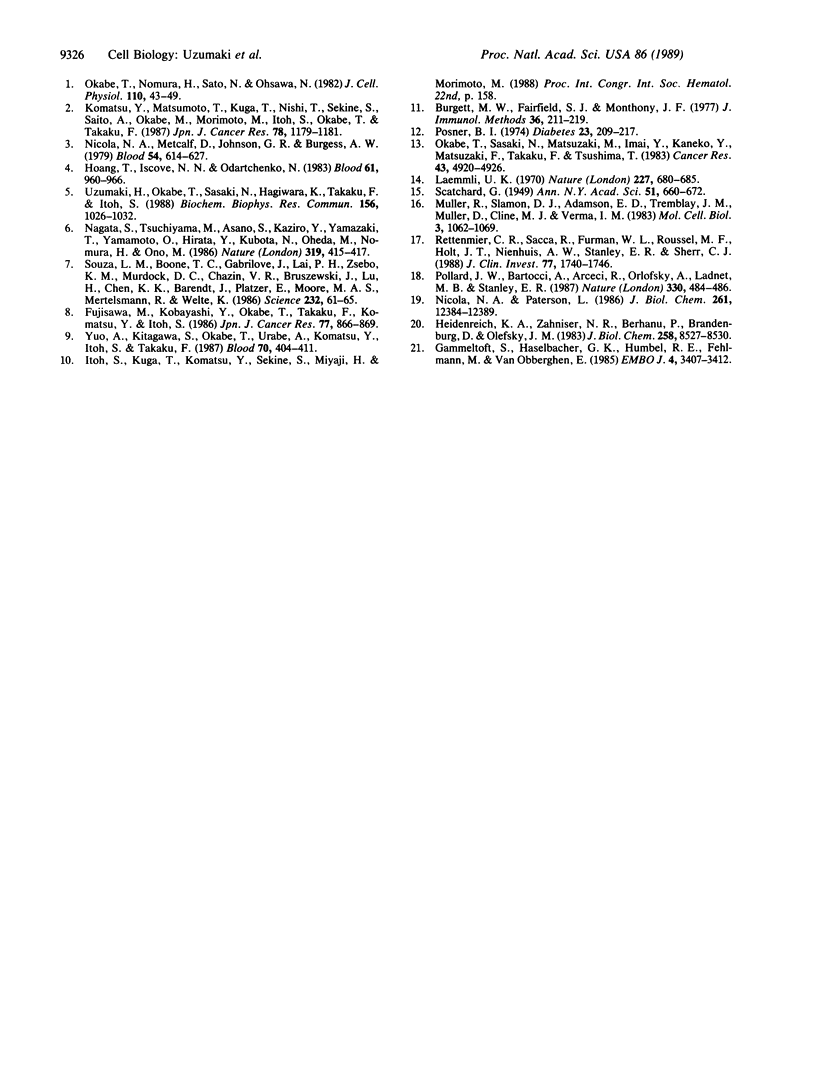
Images in this article
Selected References
These references are in PubMed. This may not be the complete list of references from this article.
- Burgett M. W., Fairfield S. J., Monthony J. F. A solid phase fluorescent immunossay for the quantitation of the C4 component of human complement. J Immunol Methods. 1977;16(3):211–219. doi: 10.1016/0022-1759(77)90199-5. [DOI] [PubMed] [Google Scholar]
- Fujisawa M., Kobayashi Y., Okabe T., Takaku F., Komatsu Y., Itoh S. Recombinant human granulocyte colony-stimulating factor induces granulocytosis in vivo. Jpn J Cancer Res. 1986 Sep;77(9):866–869. [PubMed] [Google Scholar]
- Gammeltoft S., Haselbacher G. K., Humbel R. E., Fehlmann M., Van Obberghen E. Two types of receptor for insulin-like growth factors in mammalian brain. EMBO J. 1985 Dec 16;4(13A):3407–3412. doi: 10.1002/j.1460-2075.1985.tb04097.x. [DOI] [PMC free article] [PubMed] [Google Scholar]
- Heidenreich K. A., Zahniser N. R., Berhanu P., Brandenburg D., Olefsky J. M. Structural differences between insulin receptors in the brain and peripheral target tissues. J Biol Chem. 1983 Jul 25;258(14):8527–8530. [PubMed] [Google Scholar]
- Hoang T., Iscove N. N., Odartchenko N. Macromolecules stimulating human granulocytic colony-forming cells, precursors of these cells, and primitive erythroid progenitors: some apparent nonidentities. Blood. 1983 May;61(5):960–966. [PubMed] [Google Scholar]
- Komatsu Y., Matsumoto T., Kuga T., Nishi T., Sekine S., Saito A., Okabe M., Morimoto M., Itoh S., Okabe T. Cloning of granulocyte colony-stimulating factor cDNA from human macrophages and its expression in Escherichia coli. Jpn J Cancer Res. 1987 Nov;78(11):1179–1181. [PubMed] [Google Scholar]
- Laemmli U. K. Cleavage of structural proteins during the assembly of the head of bacteriophage T4. Nature. 1970 Aug 15;227(5259):680–685. doi: 10.1038/227680a0. [DOI] [PubMed] [Google Scholar]
- Müller R., Slamon D. J., Adamson E. D., Tremblay J. M., Müller D., Cline M. J., Verma I. M. Transcription of c-onc genes c-rasKi and c-fms during mouse development. Mol Cell Biol. 1983 Jun;3(6):1062–1069. doi: 10.1128/mcb.3.6.1062. [DOI] [PMC free article] [PubMed] [Google Scholar]
- Nagata S., Tsuchiya M., Asano S., Kaziro Y., Yamazaki T., Yamamoto O., Hirata Y., Kubota N., Oheda M., Nomura H. Molecular cloning and expression of cDNA for human granulocyte colony-stimulating factor. 1986 Jan 30-Feb 5Nature. 319(6052):415–418. doi: 10.1038/319415a0. [DOI] [PubMed] [Google Scholar]
- Nicola N. A., Metcalf D., Johnson G. R., Burgess A. W. Separation of functionally distinct human granulocyte-macrophage colony-stimulating factors. Blood. 1979 Sep;54(3):614–627. [PubMed] [Google Scholar]
- Nicola N. A., Peterson L. Identification of distinct receptors for two hemopoietic growth factors (granulocyte colony-stimulating factor and multipotential colony-stimulating factor) by chemical cross-linking. J Biol Chem. 1986 Sep 15;261(26):12384–12389. [PubMed] [Google Scholar]
- Okabe T., Nomura H., Sato N., Ohsawa N. Large-scale preparation and characterization of human colony-stimulating factor. J Cell Physiol. 1982 Jan;110(1):43–49. doi: 10.1002/jcp.1041100108. [DOI] [PubMed] [Google Scholar]
- Okabe T., Sasaki N., Matsuzaki M., Imai Y., Kaneko Y., Matsuzaki F., Takaku F., Tsushima T. Establishment and characterization of a new human functional cell line from a choriocarcinoma. Cancer Res. 1983 Oct;43(10):4920–4926. [PubMed] [Google Scholar]
- Pollard J. W., Bartocci A., Arceci R., Orlofsky A., Ladner M. B., Stanley E. R. Apparent role of the macrophage growth factor, CSF-1, in placental development. Nature. 1987 Dec 3;330(6147):484–486. doi: 10.1038/330484a0. [DOI] [PubMed] [Google Scholar]
- Posner B. I. Insulin receptors in human and animal placental tissue. Diabetes. 1974 Mar;23(3):209–217. doi: 10.2337/diab.23.3.209. [DOI] [PubMed] [Google Scholar]
- Rettenmier C. W., Sacca R., Furman W. L., Roussel M. F., Holt J. T., Nienhuis A. W., Stanley E. R., Sherr C. J. Expression of the human c-fms proto-oncogene product (colony-stimulating factor-1 receptor) on peripheral blood mononuclear cells and choriocarcinoma cell lines. J Clin Invest. 1986 Jun;77(6):1740–1746. doi: 10.1172/JCI112496. [DOI] [PMC free article] [PubMed] [Google Scholar]
- Souza L. M., Boone T. C., Gabrilove J., Lai P. H., Zsebo K. M., Murdock D. C., Chazin V. R., Bruszewski J., Lu H., Chen K. K. Recombinant human granulocyte colony-stimulating factor: effects on normal and leukemic myeloid cells. Science. 1986 Apr 4;232(4746):61–65. doi: 10.1126/science.2420009. [DOI] [PubMed] [Google Scholar]
- Uzumaki H., Okabe T., Sasaki N., Hagiwara K., Takaku F., Itoh S. Characterization of receptor for granulocyte colony-stimulating factor on human circulating neutrophils. Biochem Biophys Res Commun. 1988 Oct 31;156(2):1026–1032. doi: 10.1016/s0006-291x(88)80947-1. [DOI] [PubMed] [Google Scholar]
- Yuo A., Kitagawa S., Okabe T., Urabe A., Komatsu Y., Itoh S., Takaku F. Recombinant human granulocyte colony-stimulating factor repairs the abnormalities of neutrophils in patients with myelodysplastic syndromes and chronic myelogenous leukemia. Blood. 1987 Aug;70(2):404–411. [PubMed] [Google Scholar]



